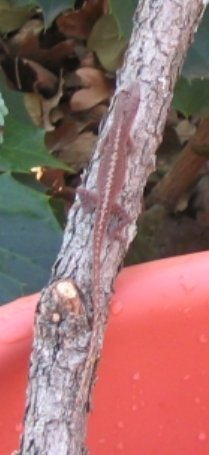Protect Your Lizards, Snakes, and Frogs - A. Brown
For the first time, I am trying to grow potatoes. I planted them in
the bottom of a very large pot, and have been adding more compost and
mulch as the plants grow.
 Being very
impatient, I went out the other day and poked around in the pot to see
if anything's growing, and was greeted by an anole, the small smooth
lizard that can camouflage himself by being green when he's on foliage,
but turns brown when near wood or soil. My yard is full of them, so
I didn't think too much about it.
Being very
impatient, I went out the other day and poked around in the pot to see
if anything's growing, and was greeted by an anole, the small smooth
lizard that can camouflage himself by being green when he's on foliage,
but turns brown when near wood or soil. My yard is full of them, so
I didn't think too much about it.
Two days later I went back out to water. My watering in the big pot
disturbed the lizard, who was still there, and while he was frantically
running around inside the pot I realized he was stuck there and couldn't
get out! The sides of the plastic pot were too smooth for him to get
a foothold and escape. I immediately found a large stick and put it
in the pot so that the bottom touched the soil and the top poked out
over the rim. Within 2 minutes, the little lizard was up and out of
there! I now have sticks in both pots, and will keep them there until
I've added enough compost over the potato plants to fill the pot.
Some other pitfalls to watch out for if you're trying to protect the
slithery wildlife in your garden:
- Shake out your water hoses before hooking them up. They make an attractive hiding place for small grass snakes, and you could harm them if you turn on the water with an attachment at the end (I've found this out the hard way).
- Likewise, shake out any watering wands before attaching them to the end of your hose. For the last several winters, we have had a lizard living in the watering wand that we leave standing upright leaning against the house.
- If you leave watering cans outside where they can fill up with rainwater, or if you leave them sitting partially full, put a tall stick inside and lean it against the rim. That way, if a frog decides to live in your watering can (I've seen that before as well!) he will have an easy way out.

